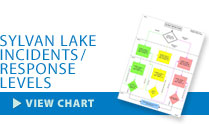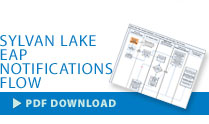Sylvan Lake EAP Case Study
The Cost vs. Liability
The Sylvan Lake Dam Conservancy District has the ability to tax homeowners and businesses at a rate of a few cents per $100 property valuation. The tax has been as little as 1 cent some years and as high as 7 cents when major work on the dam was necessary. For the IEAP, the District had issued a Request for Proposals, reviewed bids, then established a budget and set a tax rate that would pay for the breach analysis, drafting of the IEAP, and a tabletop exercise to prove its functionality and identify areas that need further discussion or development.
Siavash Beik said the cost to the District for the breach analysis, IEAP and first tabletop exercise was about $35,000. The IEAP alone was $17,000 of that amount. The preparation and execution of just an all-day tabletop exercise, and the follow-up updating of the IEAP, runs $10,000 to $12,000.
"The Sylvan Lake Dam IEAP was about the 20th one our engineering firm had completed at the time, so our process is well developed and tends to run smoothly. I am sure the process can improve and be made less expensive, though, because every time we do this we get it done a little quicker and better," Beik said.
He noted that homeowners around a private lake are sometimes surprised to learn that the dam making their lake life possible and pleasant also creates liability for them if the dam fails or has incidents that cause problems for others downstream. Neighborhood associations are sometimes able to generate assessments, and should consider doing so to obtain the benefits of having an IEAP for their dam, he said. This also is true for water supply dams owned by municipalities.
An individual who owns a dam does not have the ability to tax the neighbors to pay for a breach analysis and IEAP. However, a dam owner working closely with the local emergency manager, first responders, and the state dam safety engineers, all of whom will see contributing to an IEAP as part of their job, will greatly reduce cost. For smaller dams, the much less costly Simplified Inundation Maps (SIMS) may be all that is needed for identifying properties at risk. There may even be some state grant funding available for the work of a qualified engineer.
Beik cited the example of work by the Indiana Silver Jackets, a voluntary group of professionals from various state and federal agencies involved in dam safety. The Silver Jackets obtained funds for SIMS work at various dams throughout the state. SIMS do not constitute an IEAP, but they do provide a starting point for an IEAP. This program provides an incentive for dam owners to move forward and complete an IEAP, Beik said. Silver Jackets information is available online.
"Dam owner liability is a matter we harp on in our workshops," Beik said. "We read some information from an attorney noting that this is a litigious society, and if your dam fails a lot of people will point fingers. And you will be sued, no question. Those remarks about liability exposure often catch the attention of dam owners.
"We believe you can have a more sympathetic judge or jury if you have handled your responsibilities in a way that demonstrates a normal standard of care. We point out that the standard of care for a dam owner would be to have an inspection, to have maintenance as much as possible, and to have an IEAP so you can quickly notify emergency managers for an efficient response.
"Besides, dam owners can sleep better at night knowing that they have helped streamline the emergency detection and response processes, and that they can help save lives should an emergency occur. The rewards gained are well worth the price and effort associated with developing an IEAP and exercising it," Beik said.



